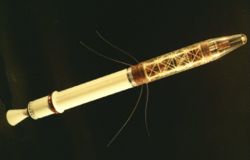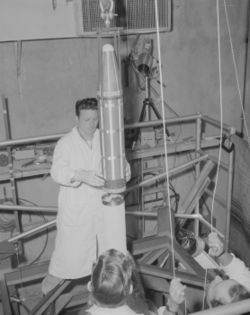Explorer 1
2008/9 Schools Wikipedia Selection. Related subjects: Space transport
| Explorer 1 Satellite 1958 Alpha |
|
 |
|
| Organization | Army Ballistic Missile Agency |
|---|---|
| Major contractors | Jet Propulsion Laboratory |
| Mission type | Earth science |
| Satellite of | Earth |
| Orbits | ~56,000 |
| Launch date | February 1, 1958 at 03:48 UTC |
| Launch vehicle | Juno I |
| Mission duration | 111 days |
| Decay | March 31, 1970 |
| NSSDC ID | 1958-001A |
| Webpage | NASA NSSDC Master Catalog |
| Mass | 13.97 kg (30.80 lb) |
| Orbital elements | |
| Semimajor axis | 7,832.2 km (4,866.6 miles) |
| Eccentricity | .139849 |
| Inclination | 33.24° |
| Orbital period | 114.8 minutes |
| Apoapsis | 2,550 km (1,585 miles) |
| Periapsis | 358 km (222 miles) |
Explorer 1 (officially titled at NASA as satellite 1958 Alpha) was the first Earth satellite of the United States, launched on February 1, 1958 at 03:48 UTC from LC-26 at Cape Canaveral Air Force Station as part of the United States program for the International Geophysical Year and in response to the launch of the Soviet satellite Sputnik 1. It was the first spacecraft to detect the Van Allen radiation belt.
Mission
The U.S. Earth satellite program began in 1954 as a joint United States Army and United States Navy proposal, called Project Orbiter, to put a scientific satellite into orbit during the International Geophysical Year. However, this proposal was rejected in 1955 by the Eisenhower administration in favour of the U.S. Navy's Project Vanguard. Following the launch of the Soviet satellite Sputnik 1 on October 4, 1957, the initial Project Orbiter program was revived as the Explorer program to catch up with the Soviet Union, beginning the Space Race.
Explorer 1 was designed and built by the Jet Propulsion Laboratory (JPL), while the Jupiter-C rocket was modified by the Army Ballistic Missile Agency (ABMA) to accommodate a satellite payload, the resulting rocket becoming known as the Juno I. The Jupiter-C design used for the launch had already been flight-tested in nose cone reentry tests for the Jupiter IRBM and was modified into Juno I. Working closely together, ABMA and JPL completed the job of modifying the Jupiter-C and building the Explorer 1 in 84 days. However, before work was completed the Soviet Union launched a second satellite, Sputnik 2, on November 3, 1957. The U.S. Navy's attempt to bring the first U.S. satellite into orbit failed with the launch of the Vanguard TV3 on December 6, 1957.
Orbit
On February 1, 1958 at 03:48 UTC the Juno I rocket was launched putting Explorer 1 into orbit, which made Explorer 1 the first Earth satellite of the United States. The orbit had a perigee of 358 kilometers (222 mi) and an apogee of 2,550 kilometers (1,585 mi) having a period of 114.8 minutes. The total weight of the satellite was 13.97 kilograms (30.80 lb), of which 8.3 kg (18.3 lb) were instrumentation. In comparison the first Soviet satellite Sputnik 1 weighed 83.6 kg (184 lb). The instrument section at the front end of the satellite and the empty scaled-down fourth-stage rocket casing orbited as a single unit, spinning around its long axis at 750 revolutions per minute.
Spacecraft design
Explorer 1 was designed and built by the Jet Propulsion Laboratory of the California Institute of Technology under the direction of Dr. William H. Pickering. It was the second satellite to carry a mission payload (Sputnik 2 was the first). The scientific instrumentation of the Explorer 1 satellite was designed and built under the direction of Dr. James Van Allen of the University of Iowa. It consisted of:
- an Anton 314 omnidirectional Geiger-Müller tube, designed by Dr. George Ludwig of Iowa's Cosmic Ray Laboratory, to detect cosmic rays. It could detect protons with E > 30 MeV and electrons with E > 3 MeV. Most of the time the instrument was saturated;
- five temperature sensors (one internal, three external and one on the nose cone);
- an acoustic detector (crystal transducer and solid-state amplifier) to detect micrometeorite ( cosmic dust) impacts. It responded to micrometeorite impacts on the spacecraft skin in such way that each impact would be a function of mass and velocity. Its effective area was 0.075 m2 and the average threshold sensitivity was 2.5 × 10-3 g cm/s; and
- a wire grid detector, also to detect micrometeorite impacts. It consisted of 12 parallel connected cards mounted in a fibreglass supporting ring. Each card was wound with two layers of enameled nickel alloy wire with a diameter of 17 µm (21 µm with the enamel insulation included) in such way that a total area of 1 cm by 1 cm was completely covered. If a micrometeorite of about 10 µm impacted, it would fracture the wire, destroy the electrical connection, and thus record the event.
Because of the limited space available and the requirements for low weight, the Explorer 1 instrumentation was designed and built with simplicity and high reliability in mind. Electrical power was provided by mercury chemical batteries that made up approximately 40 % of the payload weight.
Data from the scientific instruments was transmitted to the ground by two antennas. A 60 milliwatt dipole antenna consisting of two fibreglass slot antennas in the body of the satellite operating on 108.03 MHz, and four flexible whips forming a 10 milliwatt turnstile antenna operating on 108.00 MHz.
The Explorer 1 instrumentation payload used transistor electronics, consisting of both germanium and silicon devices. This was a very early time frame in the development of transistor technology, and represents the first documented use of transistors in the U.S. earth satellite program. A total of 29 transistors were used in Explorer 1, plus additional ones in the Army's micrometeorite amplifier.
The external skin of the instrument section was painted in alternate strips of white and dark green to provide passive temperature control of the satellite. The proportions of the light and dark strips were determined by studies of shadow-sunlight intervals based on firing time, trajectory, orbit, and inclination.
Mission results
To the surprise of mission experts, satellite Explorer 1 changed rotation axis after launch. The elongated body of the spacecraft had been supposed to spin about its long (least- inertia) axis but refused to do so, and instead started precessing due to energy dissipation from flexible structural elements. Later it was understood that on general grounds, the body ends up in the spin state that minimizes the kinetic rotational energy (this being the maximal-inertia axis). This motivated the first further development of the Eulerian theory of rigid body dynamics after nearly 200 years to address dissipation.
Sometimes the instrumentation would report the expected cosmic ray count (approximately thirty counts per second) but sometimes it would show a peculiar zero counts per second. The Iowa group (under Van Allen) noted that all of the zero counts per second reports were from an altitude of 2,000+ km (1,250+ miles) over South America, while passes at 500 km (310 miles) would show the expected level of cosmic rays. Later, after Explorer 3, it was concluded that the original Geiger counter had been overwhelmed by strong radiation coming from a belt of charged particles trapped in space by the Earth's magnetic field; this belt of charged particles is now known as the Van Allen radiation belt. The discovery of the Van Allen Belts by the Explorer satellites was considered to be one of the outstanding discoveries of the International Geophysical Year.
The acoustic micrometeorite detector detected 145 impacts of cosmic dust in 78,750 seconds. This leads for a twelve-day period to an impact rate of 8.0 × 10-3 impacts m-2 s-1.
The mercury batteries provided power that operated the high power transmitter for 31 days and the low-power transmitter for 105 days. Explorer 1 stopped transmission of data on May 23, 1958, when its batteries died, but remained in orbit for more than 12 years. It made a fiery reentry over the Pacific Ocean on March 31, 1970. Explorer 1 was the first of the long-running Explorer program, which as of November 2004 has launched 83 Explorer probes.
An identically-constructed flight backup of Explorer 1 is currently located in the Smithsonian Institution's National Air and Space Museum, Milestones of Flight Gallery.


